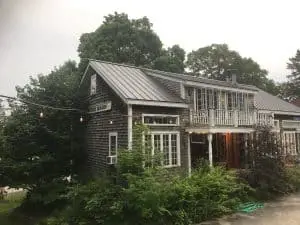The indigenous heritage of New Hampshire should never be forgotten. Native Americans once occupied large parts of New Hampshire until tensions in the state caused these tribes to seek refuge elsewhere.
Although the Native American tribes that once inhabited New Hampshire are long gone, their presence has had a significant impact on our understanding of the state, and even today, their stories are still told by many.

Today, we’ll take a closer look at the indigenous tribes that once inhabited New Hampshire, what their life was like in the state, and how they ended up displaced from their communities.
What Tribes Lived In New Hampshire?
Although there are no recognized tribes in New Hampshire today, the original tribes of the area included the Pennacook tribe and the Abenaki tribe.
The Pennacook Tribe
The Pennacook tribe, also known as Penacook and Pennacock, were a group of indigenous people that once occupied areas of New Hampshire, southern Maine, and Massachusetts.
The Pennacook tribe were Algonquian-speaking people. The Algonquian is one of the most popular and widespread native language groups in America, and they were once most prominent on the Atlantic coast.
The Pennacook tribe was closely related to the Abenaki tribe, who were thought to be subservient to the Pennacook. In New Hampshire, they lived mainly by the Merrimack River Valley.
The Pennacook was its own confederacy and is thought to have included up to 18 sub-tribes.
Some of its main tribes were Wamesit, Agawam, and Nashua, but in New Hampshire, Winnipesaukee was its main sub-tribe, which we’ll explore later.
The Language and Life Of The Pennacook Tribe
The Pennacook tribe lived a life very similar to the Abenaki tribe in Southern Maine. However, by the early 1600s, the Pennacooks began to view the Abenaki tribe as enemies, which gave way to conflict and tension.
The Pennacook tribe made their way through life by being farmers, hunters, fishers, and gatherers.
Before tensions between the tribes escalated, the Pennacook tribes lived in wigwams made from bark by the Merrimack River in New Hampshire.
It’s thought that the Pennacook tribe had approximately 30 villages with a population of up to 12,000. When tribal warfare increased, the Pennacooks traded their bark wigwams in for longhouses for extra protection.
In the Pennacook tribe, the man’s role was to protect his family. Men took the role of hunters and would go to war if needed to defend their tribe and family.
Pennacook women also played an active role in the tribe – they were often deployed as farmers and were responsible for household labor, like cooking and looking after the children.
Did You Know? The Pennacook women used to carry their children in cradleboards attached to their backs. This is a custom that has continued, and even today, other Native American (and American) parents use cradleboards.
As for clothing, the Pennacook wore distinctive items. Women could often be seen in knee-length skirts, and men typically donned leggings or loincloths.
Shirts were not considered a necessity in this culture; however, most Pennacook people would wear deerskin depending on the weather.
Other notable clothing items included earrings, worn by men and women, and moccasins on the feet.
Unlike some other Native tribes, the Pennacooks didn’t wear long headdresses. However, they could often be seen wearing headbands with feathers, and warrior men often sported mohawks to show off their status.
The Abenaki Tribe
The Abenaki Tribe was a Native American tribe that could be found in the Monadnock region of New Hampshire.
Abenaki is another collection of Algonquian-speaking people – although this is similar to the Pennacook tribe, the two share some notable differences.
The Abenaki tribe was split into two groups – eastern and western. The Eastern Abenaki lived in Maine, and the Western sub-group lived in New Hampshire.
It’s also thought that other subgroups of the Abenaki tribe existed throughout the south of New Hampshire.
Most of the Abenaki settlements were by river valleys. The tribes thrived on a natural lifestyle, and they would often rely on the natural resources in their settlements to create medicinal treatments, and they’d use crops and animals around them to sustain themselves.
Like the Pennacook, the Abenaki were fishers, hunters, farmers, and gatherers, and they were particularly fond of Deer and Moose.
Their villages were often erected near waterfalls and major rivers, and they would travel across the water in their self-made birchbark canoes.
Unlike the Pennacook, the Abenaki was a fragmented tribe with different subgroups, and for a long time, it lacked central leadership in the Northeast.
Each man in the Abenaki tribe would inherit hunting territories from his father. In the spring and summer months, they would come together and set up camp near the seacoast so they could fish and plant crops.
Compared to other tribes, the Abenaki villages were small, and most contained no more than 100 people.
Like the Pennacook, the Abenaki lived in bark wigwams; however, some eventually chose to erect long houses due to the escalating tensions between tribes. In the winter months, they would line their wigwams with animal skins, such as bears and deer, to offer extra warmth.
Contact With Europeans
In the early 1500s, European explorers came to New Hampshire, and many documented the lives of the Abenaki and Pennacook tribes.
However, more and more European explorers began to come to New Hampshire, and by the 1600s, the state’s Native American population was sent into decline.
Unfortunately, the Pennacook and Abenaki tribes, including their subgroups, had no natural immunity against the diseases bought into their settlements by European travelers.
Between 1615 and 1620, large-scale epidemics broke out throughout their regions, introducing deadly diseases like influenza and smallpox to these once-healthy, thriving tribes.
Tribal populations were quickly decimated, and their dwindling numbers were exacerbated by tensions between European settlers and other tribes.
European settlers were slowly starting to claim the ancestral lands of the Abenaki, which changed the face of the tribes as we know them.
Those that didn’t die of disease fled to other areas, moved into rural populations, or married Europeans.
Do The Tribes Exist Today?
Although the tribes as we know them no longer exist in New Hampshire, many of their descendants still live in areas like Vermont, New Hampshire, Maine, and Canada.
The Pennacook is no longer its own distinct tribe, instead known under the umbrella term of the ‘Abenaki’ people.
Today, it’s thought that approximately 3,200 Abenaki are living in Vermont and New Hampshire; however, they lack their own reservations.
The Nulhegan Band of the Coosuk Abenaki Nation is a non-profit organization, also called AHA. It’s one of four recognized tribes in Vermont and one of the largest Abenaki tribes still in existence today.
The non-profit aims to raise funds to support Abenaki citizens and protect the uniqueness and cultural heritage of the tribe.
Final Thoughts
Throughout the years, ethnocidal and genocidal attacks have decimated the population of Native tribes throughout America and New Hampshire.
The original tribes of New Hampshire helped change the face of the state we know and love today, and with the support of good people, we can continue to support what’s left of the tribes and help preserve their heritage.



